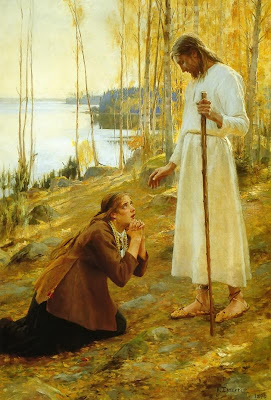America magazine's blog has
a post about Fr. Bourgeois and the letter he's written in response to the demand he recant his beliefs about women's ordination. I thought I'd post the letter here ......
**************************************
Rev. Edward Dougherty, M.M., Superior General
Maryknoll Fathers and Brothers
P.O. Box 303 Maryknoll, NY 10545
April 8, 2011
Dear Father Dougherty and General Council,
Maryknoll has been my community, my family, for 44 years, so it is with great sadness that I received your letter of March 18, 2011 stating I must recant my belief and public statements that support the ordination of women, or I will be dismissed from Maryknoll.
When I was a young man in the military, I felt God was calling me to be a priest. I later entered Maryknoll and was ordained. I am grateful for finding the happiness, meaning and hope I was seeking in life.
For the past 20 years I have been speaking out and organizing against the injustice of the School of the Americas and U.S. foreign policy in Latin America. Over these years I discovered an injustice much closer to home – an injustice in my Church.
Devout women in our Church believe God is calling them to be priests, but they are rejected because the Church teaches that only baptized men can become priests. As a Catholic priest for 38 years, I believe our Church’s teaching that excludes women from the priesthood defies both faith and reason and cannot stand up to scrutiny for the following reasons:
(1) As Catholics, we believe that we were created in the image and likeness of God and that men and women are equal before God. Excluding women from the priesthood implies that men are superior to women.
(2) Catholic priests say that the call to be a priest is a gift and comes fromGod. How can we, as men, say: "Our call from God is authentic, but your call, as women, is not"? Who are we to reject God’s call of women to the priesthood? I believe our Creator who is the Source of life and called forth the sun and stars is certainly capable of calling women to be priests.
(3) We are told that women cannot be priests because Jesus chose only men as apostles. As we know, Jesus did not ordain anyone. Jesus also chose a woman, Mary Magdalene, to be the first witness to His resurrection, which is at the core of our faith. Mary Magdalene became known as "the apostle to the apostles."
(4) A 1976 report by the Pontifical Biblical Commission, the Vatican’s top Scripture scholars, concluded that there is no valid case to be made against the ordination of women from the Scriptures. In the Episcopal, Methodist, Lutheran, United Church of Christ, Presbyterian and other Christian churches, God’s call of women to the priesthood is affirmed and women are ordained. Why not in the Catholic church?
(5) The Holy Scriptures remind us in Galatians 3:28, "There is neither male nor female. In Christ Jesus you are one." Furthermore, the Second Vatican Council’s Pastoral Constitution on The Church in the Modern World states: "Every type of discrimination … based on sex. .. is to be overcome and eradicated as contrary to God’s intent."
After much reflection and many conversations with fellow priests and women, I believe sexism is at the root of excluding women from the priesthood. Sexism, like racism, is a sin. And no matter how hard we may try to justify discrimination against women, in the end, it is not the way of God. Sexism is about power. In the culture of clericalism many Catholic priests see the ordination of women as a threat to their power.
Our Church is in a crisis today because of the sexual abuse scandal and the closing of hundreds of churches because of a shortage of priests. When I entered Maryknoll we had over 300 seminarians. Today we have ten. For years we have been praying for more vocations to the priesthood. Our prayers have been answered. God is sending us women priests. Half the population are women. If we are to have a vibrant and healthy Church, we need the wisdom, experience and voices of women in the priesthood.
As Catholics, we believe in the primacy and sacredness of conscience. Our conscience is sacred because it gives us a sense of right and wrong and urges us to do the right thing. Conscience is what compelled Franz Jagerstatter, a humble Austrian farmer, husband and father of four young children, to refuse to join Hitler’s army, which led to his execution. Conscience is what compelled Rosa Parks to say she could no longer sit in the back of the bus. Conscience is what compels women in our Church to say they cannot be silent and deny their call from God to the priesthood. And it is my conscience that compels me to say publicly that the exclusion of women from the priesthood is a grave injustice against women, against our Church and against our God who calls both men and women to the priesthood.
In his 1968 commentary on the Second Vatican Council’s document, Gaudium et Spes, Archbishop Joseph Ratzinger, now Pope Benedict XVI, said: "Over the pope … there still stands one’s own conscience, which must be obeyed before all else, if necessary, even against the requirement of ecclesiastical authority."
What you are requiring of me is not possible without betraying my conscience. In essence, you are telling me to lie and say I do not believe that God calls both men and women to the priesthood. This I cannot do, therefore I will not recant.
Like the abolition of slavery, the civil rights movement and the right of women to vote, the ordination of women is inevitable because it is rooted in justice. Wherever there is an injustice, silence is the voice of consent. I respectfully ask that my fellow priests, bishops, Church leaders in the Vatican and Catholics in the pews speak out and affirm God’s call of women to the priesthood.
Your Brother in Christ,
Roy Bourgeois, M.M.
P.O. Box 3330
Columbus, GA 31903
***************************************



































